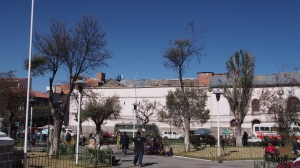City of two million inhabitants on incredibly steep slopes. A bustling, crazy hub where everything can be had. This is easily the city I’ve liked most in South America so far. Even though someone used the opportunity to claim my phone as his own. The trick is, apparently, well known. But I found out about it too late. If someone throws crumbs at your back or blows soap bubbles in your ears DON’T turn around. Lock down all your valuables and keep on going. If you turn, the distraction will be used to pickpocket you.
Apart from that, La Paz has a lot to offer. The first thing I have to mention, because it’s been a recurring theme: They do have peanut soup! After two weeks of driving through Bolivia without getting peanut soup, I finally ended up finding it in the local markets. I also found plenty of great other local food. Api, buñuelo, choyra, aji de papalisa, etc. For less than two dollars, you can get a lunch menu with soup, main dish and sometimes dessert. For a dollar you get a delicious hot corn drink and deep fried pastry for breakfast. Another thing I found is someone to fix my beloved hiking boots! It was done in less than two minutes too.
Our hostel was right in the center of the witches market. What looks like a tourist market, with tons of colourful tissues on display, takes a dark turn on the street corners, where you can buy everything from a love potion to a llama fetus. Lama fetus are an important donation to Pachamama, mother earth. It is buried in the foundation of a house to guarantee the good will of Mother Earth for that building. Bigger buildings necessitate bigger sacrifices and urban myth has it, that for big projects human sacrifices are brought. We chose not to investigate further, although the local guide swore it was absolutely true.
La Paz also has a lot of history to share. During the red cap walking tour, I learned about the infamous (and pink) San Pedro prison. A low-security prison where everyone wants to go, because it’s basically just a small town inside the town. Mostly, because the cells inside the prison are in such high demand, that you need to pay rent to stay there. Part of the appeal is that your family can come and live with you. They are free to leave whenever they want and live a normal life entering and exiting the prison many times a day. When you need to pay rent, you need to have an income and so a city formed where people buy and sell services, produce shoes and, supposedly, the cleanest cocaine in all of Bolivia.

A lot of the more recent history in La Paz was rather bloody and violent. As a reminder of this and the standoff between police and army in front of the government buildings, some of the house walls have been left unrenovated. One can still see the bullets that hit the police caserne opposite to the president palace not 20 years ago.
Lastly La Paz has one of the most original public transport systems in place: The gondolas. Absolutely amazing for us tourists to see the city, I’ve been told it’s too expensive for most local to use. It remains a nice gimmick for us though. One of those gondolas leads up to El Alto famous for the worlds largest market with over 5km length and the Chollita wrestling. The market was … complicated, we somehow never made it out of the section that shows you the used car parts. But we’ve been told you can get absolutely everything there, you just need to know where.
The chollita wrestling was absolutely amazing. For one it was clearly visible that this is a joint effort, that the two wrestlers collaborate to pull of their more impressive stunts. For second these ladies manage to pull those stunts off in their traditional outfits, containing up to seven layers of skirts. The flying skirts added their own drama to the show, much more than any tight wrestler outfit could.
The most famous tourist activity in La Paz, however, is something else: The death road. Named this way when it was still dangerous. Back in the day, the death road was the only road up or down into the valley. It was barely large enough for one car, let alone two going in opposite direction. Big cliffs, high speeds and drunken drivers did their rest to make this road the most accident prone and deadly road. However Bolivia’s government has since closed down this road for traffic and built a tarred, two-lane road on the opposite side of the valley.
Today the death road is only open to tourists on their bikes and barely carries any risk. It is a whole lot of fun to speed down the road, through rivers and cascades and amazing landscapes. Unfortunately, we didn’t have the best weather.. It didn’t diminish the fun driving, but it did obscure the scenery.
















